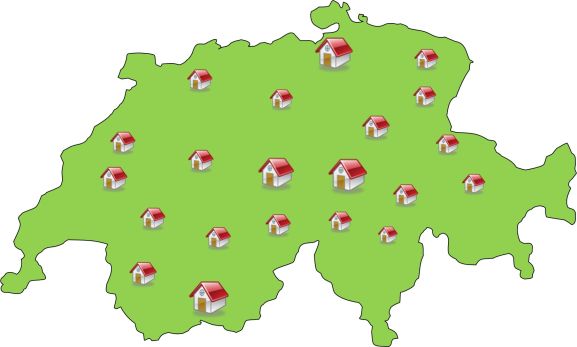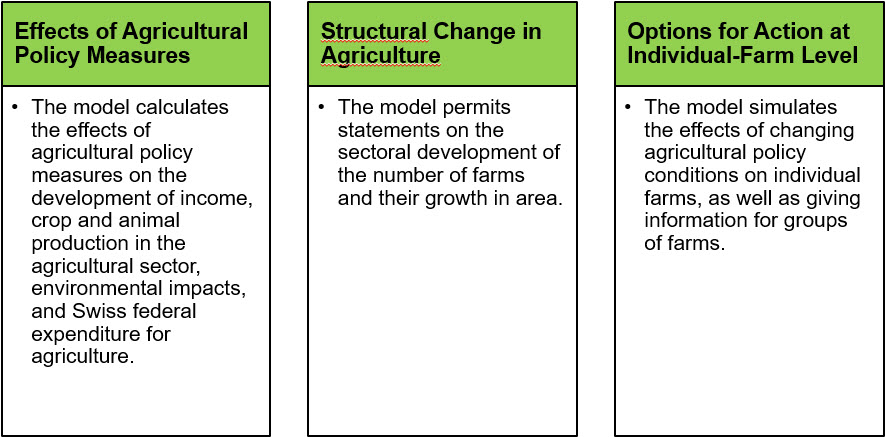SWISSland - Structural Change Information System Switzerland
The SWISSland model system illustrates supply-and-demand quantities of agricultural raw products in the Swiss agricultural sector and projects future trends for these whilst taking account of (nett) external trade in agricultural goods on the global market.
SWISSland serves to evaluate the consequences of agricultural policy measures, the impact of internal and external market influences, and the effects of the heterogeneous site conditions specific to the alpine region on income trends, structural change and land management in the Swiss agricultural sector.
Developed by the 'Economic Modelling and Policy Analysis' Research Group, Strategic Research Division (RD) 'Competitiveness and System Evaluation' at Agroscope’s Tänikon site, and employed primarily as a policy advisory tool, SWISSland has been used since 2011 to analyse agricultural policy issues.
Model Design SWISSland
SWISSland is a hybrid model combining optimisation and simulation methods on both a micro- and macro- (i.e. sectoral) level.
One main focus of the SWISSland model is the supply module, in which over 3000 farms organised into ‘communities’ exchange land with one another and optimise their portfolio annually in terms of prices and direct payments. The agent-based model approach also allows subjective behaviour on the part of the farm manager to be taken into account during decision-making. A recursive-dynamic model approach, in which previous production capacities and investments effected on the basis of production decisions are carried over from one year into the next, was found to be appropriate for the individual-farm optimisation models. SWISSLAND is designed to simulate medium-term adaptation reactions of around 10–15 years. On the basis of these farms, and once the optimisation process has taken place, a relatively complex extrapolation to Switzerland’s entire sector is performed.
Located downstream of SWISSland are various tools from the environmental sector which allow statements on trends in environment-related parameters such as nitrogen balance to be made for the different model scenarios.
Data-Input
Calculations in the SWISSland supply module always begin with a reference year essentially based on information from the accounts department, and on further data from external sources.
SWISSland uses various external requirements.
Data Output
Based on the income and the activity-sector preferences of the farm manager’s family to date, the SWISSland model optimises the production of the individual agents furnishes sectoral parameters. First and foremost, these include product-quantity, land-use and workforce trends, as well as income trends according to agricultural accounting, sectoral input and output factors for calculating environmental impacts, and important structural indicators such as the number of farms, farm sizes and types, or the number of farms that have changed their form of agriculture.
Output parameters of the supply module
The output parameters for the ex-ante analyses and their degree of aggregation depend essentially on the wishes of those commissioning our calculations. A selection of these parameters is normally published in reports for the Federal Administration, or in articles in journals.
Supply Module
Agent decision models
The modelling of agent decision-making behaviour can be subdivided into separate (micro-) decision models that are individually parameterised and modelled as autonomous processes. Initially this occurs independently. Within a simulation run, however, these decision models are sequentially adjusted to one another, then coordinated.
The following decision areas are modelled in SWISSland:
- Production decisions
- Farm growth and investment
- Change in land-use regime (conversion to organic farming)
- Farm exit and succession
- Land exchange through lease
Individual farm models
The production-and-investment-decision model of the individual agents is formulated as a mathematical optimisation model. The individual farm models illustrate the farm with all of its specific production and income possibilities, whilst bearing in mind the individual provision of the necessary production-capacity resources. One of the most important assumptions of the individual-farm models is that the farms maximise their expected household income, which consists of the sum of the agricultural and non-agricultural incomes.
Information Technology Solution
SWISSland consists of various software components that communicate with one other via interfaces.
1. MySQL Database
- Accountancy data
- Simulation-control data for flow control and data-transfer control
- Group configuration data for forming population clusters and SWISSland communities
- Input and output data for illustrating behaviour algorithms in the decision-making process for each individual agent
2. Java Platform
- Modelling of database interfaces and program control
- Modelling and control of agent decision models
- Modelling of agent interactions
- Modelling of extrapolation to the entire sector
- Sequencing of model flow and interface function between the model components
3. GAMS Optimisation Models
- Input-and output-data processing tool
- Optimisation of agent production and investment decisions
- Calibration of the model
The information technology solution was implemented in collaboration with BMPI, Zurich
















